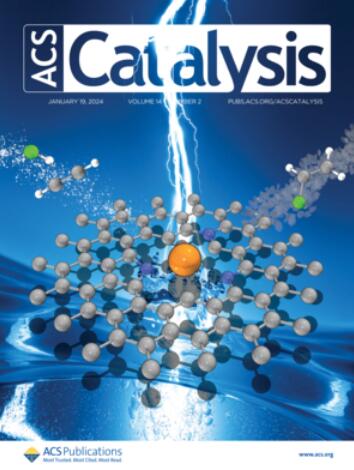Visible-Light-Driven Borylacylation of Alkenes by NHC/Photoredox Dual Catalysis: Accessing Boryl 1,4-Dicarbonyl Architectures
IF 11.3
1区 化学
Q1 CHEMISTRY, PHYSICAL
引用次数: 0
Abstract
Boron-containing carbonyl compounds serve as versatile synthons in organic synthesis, materials science, and medicinal chemistry, with boryl dicarbonyl compounds emerging as privileged precursors for the construction of borylated heterocycles. Despite their utility, efficient synthesis of these architectures from readily available starting materials remains challenging, particularly those requiring concurrent borylation and acylation. Herein, we present a transition-metal-free strategy for modular assembly of boryl 1,4-dicarbonyl compounds via synergistic photoredox/N-heterocyclic carbene (NHC) dual catalysis. The reaction proceeds through regioselective alkene difunctionalization involving NHC-attached ketyl and NHC-boryl radicals, achieving good chemo- and diastereoselectivity. This protocol demonstrates broad functional group tolerance (44 examples) and scalability (gram-scale synthesis), while mechanistic studies (radical blocking and electron paramagnetic resonance (EPR) detection) corroborate the generation and coupling of two radical species. The synthetic versatility is further highlighted by downstream transformations into pharmaceutically relevant multisubstituted boryl γ-lactones and 1,2-benzazaborines.

NHC/光氧化还原双催化下烯烃的可见光驱动硼酰化:获得1,4-二羰基结构
含硼羰基化合物在有机合成、材料科学和药物化学中具有广泛的用途,其中硼基二羰基化合物是构建硼化杂环的优越前体。尽管它们很实用,但从现成的起始材料中有效地合成这些结构仍然具有挑战性,特别是那些需要同时进行硼化和酰化的结构。在此,我们提出了一种无过渡金属的策略,通过协同光氧化还原/ n-杂环碳(NHC)双重催化,对硼基1,4-二羰基化合物进行模块化组装。反应通过区域选择性烯烃双官能化进行,涉及nhc -连接的烷基和nhc -硼基自由基,达到良好的化学选择性和非对映选择性。该方案显示了广泛的官能团耐受性(44个例子)和可扩展性(克级合成),而机理研究(自由基阻断和电子顺磁共振(EPR)检测)证实了两种自由基的产生和偶联。下游转化为药学上相关的多取代硼基γ-内酯和1,2-苯扎硼烷,进一步突出了合成的多功能性。
本文章由计算机程序翻译,如有差异,请以英文原文为准。
求助全文
约1分钟内获得全文
求助全文
来源期刊

ACS Catalysis
CHEMISTRY, PHYSICAL-
CiteScore
20.80
自引率
6.20%
发文量
1253
审稿时长
1.5 months
期刊介绍:
ACS Catalysis is an esteemed journal that publishes original research in the fields of heterogeneous catalysis, molecular catalysis, and biocatalysis. It offers broad coverage across diverse areas such as life sciences, organometallics and synthesis, photochemistry and electrochemistry, drug discovery and synthesis, materials science, environmental protection, polymer discovery and synthesis, and energy and fuels.
The scope of the journal is to showcase innovative work in various aspects of catalysis. This includes new reactions and novel synthetic approaches utilizing known catalysts, the discovery or modification of new catalysts, elucidation of catalytic mechanisms through cutting-edge investigations, practical enhancements of existing processes, as well as conceptual advances in the field. Contributions to ACS Catalysis can encompass both experimental and theoretical research focused on catalytic molecules, macromolecules, and materials that exhibit catalytic turnover.
 求助内容:
求助内容: 应助结果提醒方式:
应助结果提醒方式:


